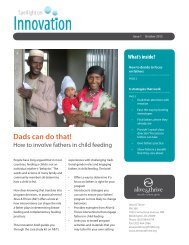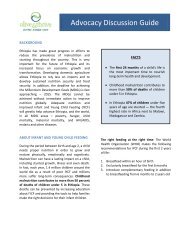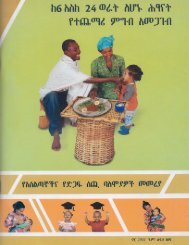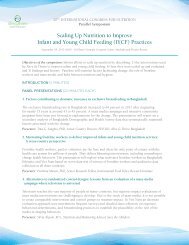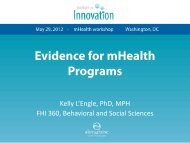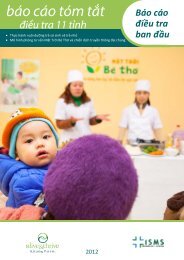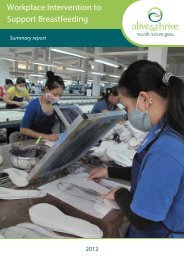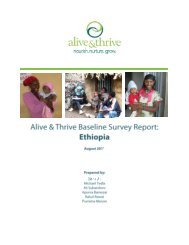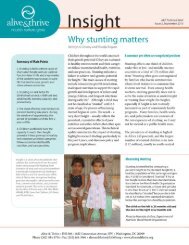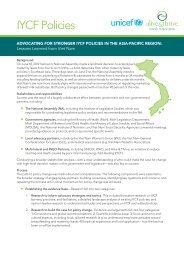IYCF Practices, Beliefs, and Influences in SNNP ... - Alive & Thrive
IYCF Practices, Beliefs, and Influences in SNNP ... - Alive & Thrive
IYCF Practices, Beliefs, and Influences in SNNP ... - Alive & Thrive
You also want an ePaper? Increase the reach of your titles
YUMPU automatically turns print PDFs into web optimized ePapers that Google loves.
Mothers expla<strong>in</strong>ed that husb<strong>and</strong>s are primarily responsible for work on the farm <strong>and</strong> br<strong>in</strong>g<strong>in</strong>g foodhome for household consumption, although some mothers said that they, too, go to the market to buyfood. Food purchas<strong>in</strong>g is often done by the father, but <strong>in</strong> many cases the fathers provides money to themothers to purchase food from the market herself. The role of other family members appears to be tothat of prepar<strong>in</strong>g food <strong>and</strong> feed<strong>in</strong>g the child ma<strong>in</strong>ly dur<strong>in</strong>g the mother’s absence. In most of theobservations, the mother alone prepared food <strong>and</strong> fed her child, although <strong>in</strong> one case the mother’smother <strong>and</strong> sister helped to ma<strong>in</strong>ta<strong>in</strong> the cook<strong>in</strong>g fire <strong>and</strong> prepare the food.In terms of offer<strong>in</strong>g advice, mothers <strong>in</strong> all three communities overwhelm<strong>in</strong>gly mentioned HEWs as theirma<strong>in</strong> source of <strong>in</strong>formation on child feed<strong>in</strong>g. With<strong>in</strong> the home <strong>and</strong> community, mothers mentioned thatthey receive advice on feed<strong>in</strong>g from their own mothers or mothers-<strong>in</strong>-law, especially advice related tobreastfeed<strong>in</strong>g <strong>and</strong> <strong>in</strong>troduction of foods. Of the mothers who practice non-exclusive breastfeed<strong>in</strong>g <strong>and</strong>early <strong>in</strong>troduction of foods, most said that these practices are customary <strong>in</strong> their community <strong>and</strong> spokeof be<strong>in</strong>g <strong>in</strong>fluenced by their mothers, gr<strong>and</strong>mothers, mothers-<strong>in</strong>-law, <strong>and</strong> sometimes village elders.Neighbors <strong>and</strong> other mothers were also cited as sources of advice <strong>in</strong> two of the communities.Husb<strong>and</strong>s appear to <strong>in</strong>fluence child feed<strong>in</strong>g practices <strong>in</strong>directly, primarily <strong>in</strong> their role as provider <strong>and</strong> asthe one who controls family f<strong>in</strong>ances. While only two mothers mentioned their husb<strong>and</strong>s as a directsource of advice, many who discussed giv<strong>in</strong>g or not giv<strong>in</strong>g certa<strong>in</strong> foods expla<strong>in</strong>ed that they do so basedon their husb<strong>and</strong>’s advice or approval. In some cases, mothers said they would be able to followrecommended practices, such as <strong>in</strong>creased feed<strong>in</strong>g frequency <strong>and</strong> quantity or giv<strong>in</strong>g specific types offood, if their husb<strong>and</strong> provided the food or gave them money to buy food. HEWs are conv<strong>in</strong>ced that theavailability of different food items <strong>and</strong> support from family members are the key reasons beh<strong>in</strong>d somechildren gett<strong>in</strong>g enough to eat.When asked what more could be done to promote child feed<strong>in</strong>g <strong>in</strong> communities, some mothers as well asfathers <strong>and</strong> gr<strong>and</strong>mothers suggested that an effort should be made to <strong>in</strong>crease <strong>in</strong>volvement of fathers<strong>and</strong> other family members <strong>in</strong> support<strong>in</strong>g mothers <strong>in</strong> child feed<strong>in</strong>g. Suggestions <strong>in</strong>cluded provid<strong>in</strong>g themother with more help <strong>in</strong> the home, as well as for fathers provid<strong>in</strong>g more food from farm l<strong>and</strong>, sell<strong>in</strong>gfarm products to purchase food, or barter<strong>in</strong>g with<strong>in</strong> the community to access more foods. VCHPs <strong>and</strong>HEWs all agreed that fathers <strong>and</strong> other family members could all play a larger role, <strong>and</strong> that theyshould be given more <strong>in</strong>formation on child feed<strong>in</strong>g <strong>and</strong> be<strong>in</strong>g <strong>in</strong>cluded <strong>in</strong> promotion activities.The majority of mothers feel that HEWs are the best source of advice. Other mothers prefer receiv<strong>in</strong>gadvice from their elders or mothers-<strong>in</strong>-law, who can share their own experience rais<strong>in</strong>g children, whileothers like to seek advice from promoters or an educated person liv<strong>in</strong>g <strong>in</strong> their community.“HEWs are the best to give advice. They are knowledgeable; they know more aboutfeed<strong>in</strong>g than community leaders. Traditional birth attendants <strong>and</strong> religious leaders <strong>and</strong>doctors know more than HEWs, but I prefer a person from the local area, who knows ourlocal language <strong>and</strong> I am not afraid of them. They come to our house every time <strong>and</strong> we canf<strong>in</strong>d them easily.” -A mother <strong>in</strong> Misha“There is one farmer <strong>in</strong> our village, his name is Melesse, <strong>and</strong> he is educated. He tells ushow to feed children when we are gather<strong>in</strong>g. The community elders <strong>and</strong> HEWs also give usadvice” -A mother <strong>in</strong> Misha26



